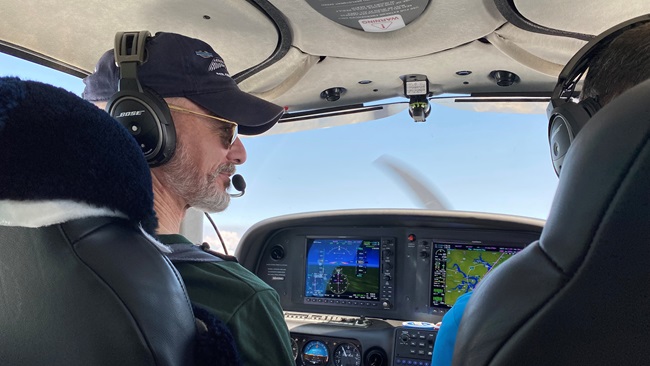People: Citizen of the World
Earthrounder completes pole-to-pole flight

Photography and illustration courtesy of Robert DeLaurentis.
 The former U.S. Navy officer, author, and self-described Zen Pilot logged 26,000 miles over 22 countries and six continents during a five-month mission that stretched to nine months because of fallout from the coronavirus pandemic.
The former U.S. Navy officer, author, and self-described Zen Pilot logged 26,000 miles over 22 countries and six continents during a five-month mission that stretched to nine months because of fallout from the coronavirus pandemic.
After the South Pole crossing in December, DeLaurentis notched several firsts, including: using biofuels over the South Pole; tracking over the pole with ADS-B equipment; setting time and distance marks for a Twin Commander; carrying a NASA wafer scale spacecraft prototype for interstellar probes; sampling the polar atmosphere for plastic fibers that travel through the air; and providing science, technology, engineering, and math (STEM) outreach to those he interacted with along the way.
He helped celebrate AOPA’s eightieth anniversary year by dedicating an Antarctica flight leg to the pilot association that “has been with me since I first started to fly.”
While he was on a planned stop for several weeks in Spain the country was overrun by the coronavirus. Before the coronavirus spread to the United States DeLaurentis provided AOPA members with practical insight and safety tips that he gleaned in Europe.
The 2015 earthrounder said he learned as much about himself as he did about others and often dug deep to muster self-confidence and to leverage ingenuity when the chips were down.
DeLaurentis described a staggering navigation challenge when most of his on-board flight management and navigation systems failed above the South Pole in December—and he experienced the same glitches again over the North Pole in July.
“I’m five hours of flight time from land, 30,000 feet up over a cloud layer at a wrong-way altitude doing almost 400 mph over the North Pole with no comms,” he recalled. He instead relied on “a simple $1,000 iPad” to show him the way. DeLaurentis said he flew across the South Pole twice—and the North Pole three times—to make sure he accomplished his polar circumnavigation goals.
He conquered other challenges along the way: Headwinds threatened but didn’t derail meticulously planned flight endurance legs; extremely low atmospheric temperatures worried him about fuel gelling that could starve the two Honeywell TPE 331-10T engines; landing permissions and takeoff protocols during COVID-19 restrictions constantly changed; a burst ferry tank in the Gulfstream’s cabin flooded the aircraft’s interior with fuel.
Despite the challenges of completing a world journey during a global pandemic, DeLaurentis managed to look on the bright side. He met monks who preached patience, youth who taught him about appreciating life’s simpler joys, and he fell into a “deeply reflective state of mind” that allowed him to feel connected to others in a unique way. He described it as a “stunningly beautiful experience and one of the many steps that redefined” him as a Citizen of the World.
He wrote in a blog post that his view of different cultures changed when he “saw people cooperating rather than competing” with each other. “All the people along the way who helped me, even when it wasn’t necessarily to their initial benefit, helped me see that when we work together, we can accomplish so much more. I came to understand that working together as Citizens of the World would be the only way ahead for the planet as we tackle things that we never would have expected.”
Email [email protected]



